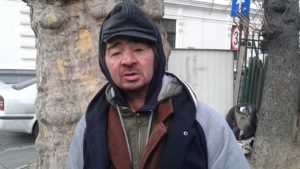“The local authorities in Bucharest, Romania, don’t have any official statistics on the city’s homeless population.” According to a local NGO, there were about 5,000 people in 2010. Read the story of Florian, by Vlad Odobescu, who cannot go to shelters because of his alcoholism.
 Florian Ghiocel, photo by Vlad Odobescu
Florian Ghiocel, photo by Vlad Odobescu
At any given moment, Florian Ghiocel – a homeless man wandering close to the centre of Bucharest, Romania – keeps a plastic bottle of red wine in sight. While he guards the cars in a small parking lot for a tip, the bottle is on a box close by. As we are walking around the neighbourhood, and he shows me the freshly renovated buildings he used to squat, he puts the bottle under his winter jacket.
Florian is moving slowly and his eyelids are heavy, but he is coherent and reasonable. It is a cold day in Bucharest, below zero Celsius, but he doesn’t seem to feel it. He says that he has lived on the streets for the last 23 years. For all this time, he has slept in parks, staircases, abandoned buildings or, as today, in a parking lot. Over the last winter, he survived nights with -22 degrees Celsius. He believes that drinking and faith helped him.
Before we enter the “Holy Trinity” Orthodox church, one of the places on his personal map, Florian is buying another bottle from a nearby store and a pack of cigarettes. He pays only a euro and a half for 1.5 litres. “It’s clean,” he assures me. At the gate of the church, he finishes his cigarette and hides both bottles under the jacket. He doesn’t want to upset God – or at least the priest – with his habit. In the semi-dark inside, Florian is taking off his cap, revealing a tuft of black tangled hair and long sideburns.
Viorica, an old woman who serves as a sort of caretaker of the church, is packing some calendars while looking suspiciously at Florin. He is kissing all the icons and making crosses in front of the altar. When he returns, Viorica tries to convince him to go to a public shelter.
“You’re not allowed to get inside with the bottles. They would throw them away,” Florian says. Viorica tells him that, in this case, he needs to stop drinking. He keeps calm as he listens to her plea. In the end, he asks her for an Orthodox calendar, one where all the religious celebrations are marked, so he can get some alms after services.
 Florian Ghiocel, photo by Vlad Odobescu
Florian Ghiocel, photo by Vlad Odobescu
Florian will continue to live in his corner of the parking lot, no matter how harsh the winter will be. In recent years, he was in a shelter for only six days in total.
After all, there are a lot of people like him. He knows of about 300 living right in the centre. “A lot of us don’t go to shelters any more”, Florian says.
***
The local authorities in Bucharest don’t have any official statistics on the city’s homeless population. According to Samusocial Romania, a local division of an international NGO, in 2010 there were about 5,000 people living on the streets of Romania’s capital. The officials we talked with say that the number still seems accurate at the end of 2016. We don’t know how many of them are dying each year.
Six years ago, 21 percent of Bucharest’s homeless population spent their cold winter days in staircases of apartment buildings, while 11.6 percent stayed in train stations, 9.3 percent found shelter in barracks, trailers or abandoned cars, and 4.7 percent lived in sewers, revealed a report published by Samusocial.


Container Of A Shelter, photo by Vlad Odobescu
No other relevant studies on such topics were published since, but some events intervened: in July 2015, hundreds of people living in the underground tunnels and sewers at Gara de Nord, Bucharest’s main railway station, were evacuated, following the arrest of a drug dealer known as Bruce Lee. Most of them were drug addicts, and they spread around the city looking for an area to settle.
The number of people who found a place in a public shelter has increased in recent years, but it still seems low compared to the needs. The biggest centre in Bucharest run by the city hall – the integrated complex of social services for adults, Sfantul Ioan – can offer emergency overnight shelter for 560 people. In addition to that, local districts have a total of 280 places in smaller centres. A new one with about 50 places is about to be opened in District 4.
When temperatures go way below zero, the places are supplemented with mattresses or military folding beds, says Ionuț Voicu, coordinator of the Sfantul Ioan centre. When the homeless people won’t come themselves, they are gathered by mobile teams or by ambulances, Voicu explained. Just the afternoon before we visited the centre, around 20 ambulances brought temporary residents in suffering from the cold.
Some of the rooms in the overnight shelter are used on a six-month term, by people who need provisional housing. Recently, the authorities noticed a flux of people with no real problems benefiting from the free service. Some were retirees who had a home, but didn’t want to pay bills during winter, taxi drivers, or employees of construction companies. So they decided to ask for around 15 papers, from financial authorities, local administrations, or other institutions. However, for the emergency housing, only the ID card is needed. At least for now.
***
Most of those coming to the emergency shelter are men aged between 50 and 70. While they are inside, they can take a hot shower, eat, get new clothes, and benefit from assistance for reintegration. “Some of them can be saved,” Voicu tells us.
Others are harder to save, but they still need help to go on with their lives. Although alcoholism is not an important cause of homelessness in Bucharest – only 1 percent admit that, according to a study of Samusocial – a lot of them are drinking in order to endure the hard life in the street.
Ionuț Voicu says that he can understand their need for a drink: “I can put myself in their place. They lost their house or they were kicked out by their relatives. How can they otherwise drown their sorrow? With the help of alcohol or cigarettes or other stuff.” But alcohol is strictly forbidden inside: the bottles would be confiscated and given back to them after.
Voicu had never heard about the so-called “wet houses,” shelters where homeless residents are allowed to drink. After such a programme started in Seattle, USA, the consumption decreased consistently among those inside. That further brought lower costs for the city: where before the authorities spent 8.2 million dollars for a group of homeless people per year (an average of 4,066 dollars per month for a single person), the cost dropped to 958 dollars per person per month after a year.
“I never heard about wet houses,” Voicu told us. “Maybe it’s different for them. For Romania it would be strange. People are unpredictable when it comes to alcohol: some would just fall asleep, others would create scandals.”
In the centre he leads, those who are coming in drunk are put in the eight containers in the courtyard, with four beds each. They can do whatever they want there, far from the others.
 Container Inside, photo by Vlad Odobescu
Container Inside, photo by Vlad Odobescu
***
Florian says that, from time to time, some demons surround him. But he learnt not to be afraid, as they are just decayed human souls. He stops in the middle of a church courtyard and talks casually to these invisible creatures: “How many are you here? One of you speak!” There is no answer, so he resumes walking. At some point, he will stop for a sip, because here he is free to do that.
Vlad Odobescu




